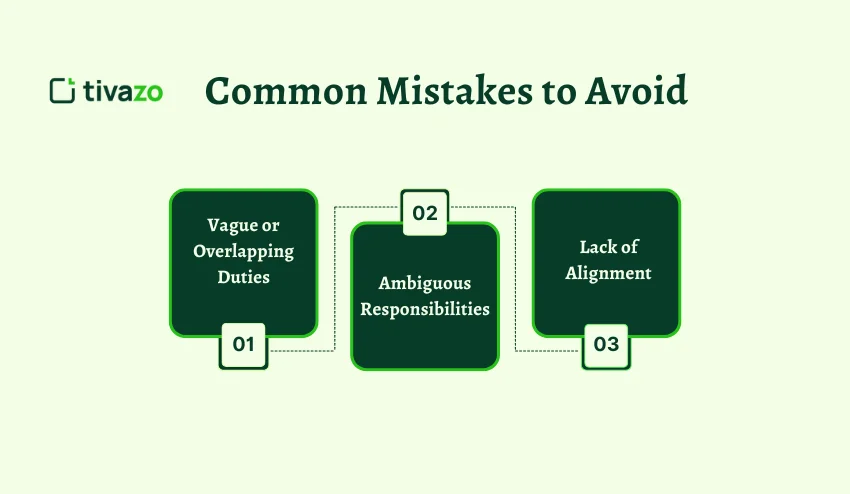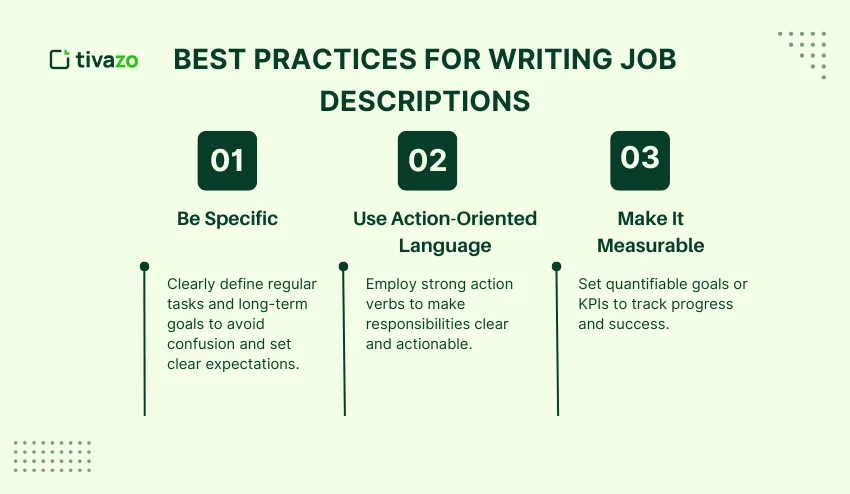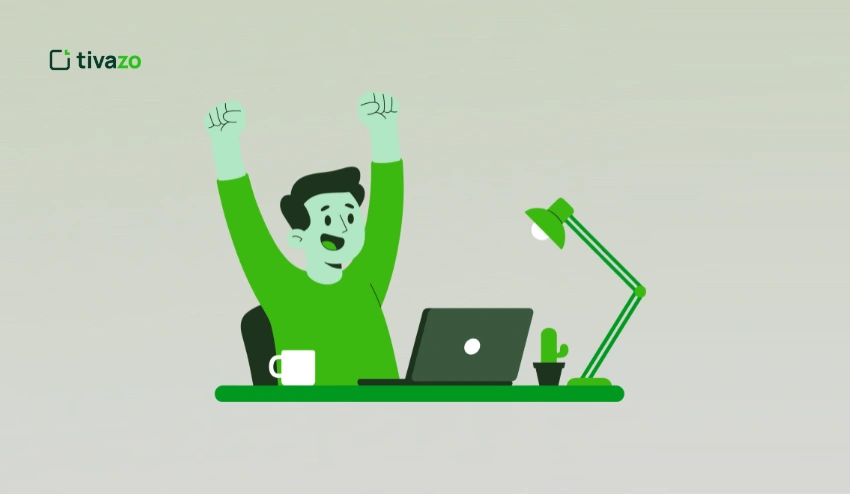Job duties and responsibilities are two important components of a job description, and it is very important that both employees and employers have knowledge of the difference between the two. Job responsibilities are broader and describe the end-term objectives and responsibilities of the job, whereas job duties specify the exact tasks that an employee has to perform. They are both necessary in formulating clear expectations and making employees aware of what is actually expected of them.
This guide will describe the difference between job duties and responsibilities, why it is important, and how you can specify them in your job descriptions to enhance employee performance and organizational success.
Key Highlights:
- What Are Job Duties
- What Are Job Responsibilities
- Powerful Insights into Job Duties and Responsibilities
- How They Work Together
- Why Defining Job Duties and Responsibilities is Crucial
- Common Mistakes to Avoid
- The Impact of Clear Job Duties and Responsibilities
- Best Practices for Writing Job Descriptions
What Are Job Duties?
Job duties refer to the tasks that an employee has to perform daily. They are action plans, measurable, and have a direct impact on the performance of the employee on a day-to-day basis. The job description also allows employees to be aware of their position individually in the team and the immediate effect of their effort on the activities of the company.
Examples of Job Duties:
- Handling of customer transactions at a retail shop.
- Coding a software application.
- Email campaign management in a marketing department.
The nature of job responsibility is usually short-lived, and expectations are daily or weekly. Defined job responsibilities give the employees a guide on what to do on day-to-day activities and hold performance expectations more realistic.
What Are Job Responsibilities?
Where job duties are concerned with particular tasks, job responsibilities are wider in the scope of the goals an employee is responsible for in the position. The job duties are usually aimed at long-term objectives, management areas,and business leadership within the company.

Examples of Job Responsibilities:
- Running performance and targets of a team.
- Customer satisfaction through all the service channels.
- The creation and implementation of a marketing plan to develop the company.
Job responsibilities relate to the general responsibility of an employee in the organization and assist in determining his or her contribution towards the strategic goals of the company.
7 Powerful Insights into Job Duties and Responsibilities
Strong Insights are the following:

1. Clarity Reduces Confusion
A clear role of duties and responsibilities removes confusion on expectations and standards of performance. This transparency results in increased productivity and reduced errors.
- Workers are aware of what they are supposed to do, and it eliminates mistakes.
- Roles enhance group communication.
- Assists in establishing measurable performance goals.
2. Job Duties Are Short-Term, Responsibilities Are Long-Term
It is necessary to learn how to differentiate between actionable items and general objectives. A job’s responsibilities are to be based on weekly or daily tasks, whereas responsibilities define bigger goals and the contribution made by an employee in the success of the organization.
- Job responsibilities are time-limited and can be assessed within a short period of time.
- Duties are in line with the corporate vision and long-term plan.
- Sustained commitments contribute to career choices.
3. Alignment With Organizational Goals Drives Success
Employees are better placed to be motivated and engaged when they appreciate their position in line with the mission of the company and how their duties and responsibilities relate to it. The job roles must invariably contribute to the larger organizational goals.
- Employee engagement is motivated by clear goal alignment.
- Makes the employees feel that their efforts are being felt within the company.
- Promotes competition and long-term orientation.
4. Job Descriptions Should Be Measurable and Specific
Define duties and responsibilities in specific language and using measurable goals. As an example, rather than managing a team, manage a team of 10 to achieve quarterly sale targets. This facilitates clearer expectations and makes them achievable.
- Special descriptions establish attainable performance metrics.
- Specific objectives can be used to monitor progress and increase productivity.
- Offers a foundation on which the performance reviews and feedback are based.
5. Career Development Is Tied to Role Clarity
Workers who know their roles and tasks are more favourable to career development. Definitive descriptions enable the employees to see where they can do better and seek improvement prospects.
- Brings into perspective the weaknesses that employees have.
- There is more alignment with career aspirations due to the role clarity.
- Sponsors training programs and development.
6. Avoiding Overlap Enhances Efficiency
Confusion and inefficiencies can be caused because there is ambiguity or overlapping duties. A set of tasks and responsibilities of each role must be defined and distinctly spelled out to enhance the coordination of teams and their performance.
- Minimizes role ambiguity and conflicts within the team.
- Roles are clearly defined, which increases the delegation of tasks.
- Enhances a lean way of working and decision-making.
7. Legal Compliance Is Critical
Make sure that job descriptions are in line with the labor laws and regulations. Lack of proper definition of the duties and responsibilities may put the organization at legal risk, particularly the laws of equal opportunity and wages.
- Violation of labor laws may become a problem.
- The role definition helps to avoid discrimination and provides fairness.
- Helps prevent conflicts of pay, benefits, and rights of the employees.
How Job Duties and Responsibilities Work Together
Job duties and responsibilities are supposed to work together, creating a balanced job description. Though duties are the distinct things that the employees should perform, responsibilities are the broad range of things that the employees need to perform. The combination of them makes sure that employees are not only aware of what is expected of them but also know how their contribution to the overall success of the company works.
Example:
In a Customer Service Representative job:
- Job tasks may consist of customer phone calls, problem-solving and dealing with transactions.
- During the work, job requirements would consist of customer satisfaction levels, representing the company values, and customer relations.
When defined in a clear manner, the employers would create clear expectations and lessen misunderstandings and enhance performance overall.
Why Defining Job Duties and Responsibilities is Crucial
To employees and employers, jobs are the most critical success factors that have well-defined duties and responsibilities. A clear definition of roles will provide employees with a clear idea of what they do in their everyday work and what they should achieve in the long term to concentrate their efforts. All these make the work environment less confusing, more motivating, and more performance-driven.
For Employers and Employees, defined job duties and responsibilities are crucial for success. Here’s why:
- To Employees: Understanding of job duties and responsibilities results in increased motivation, job satisfaction, and career development. When the employees are aware of what is expected of them, they are able to prioritize their work and work more efficiently.
- To Employers: The role definition enhances efficiency, accountability, and goal orientation to the company’s objectives, leading to better organizational goals performance. It also aids in the determination of areas of development and provides assistance in teams.
Impact: Employees know what to do, and they therefore coordinate their efforts to organizational goals, which increases productivity and satisfaction. Well-defined roles provide a culture of responsibility and boost the overall performance.
Common Mistakes to Avoid When Defining Job Duties and Responsibilities
In job description making, particular pitfalls to be avoided are:

1. Vague or Overlapping Duties
Poor role definition or duplication may make employees uncertain about what is expected, and hence reduce performance. The conflict of roles may also lead to team conflicts.
Solution: Every duty should be clearly defined, and no two positions should be similar.
2. Ambiguous Responsibilities
General or vague duties may end up confusing the employees regarding their contribution to the attainment of the company’s objectives, impacting motivation and job satisfaction.
Solution: Differentiate responsibilities and make them based on measurable results that are linked to organizational goals.
3. Lack of Alignment
Employees will be distracted when they do not see the job duties and responsibilities being aligned to the mission of the company, resulting in reduced productivity.
Solution: Regularly review job roles to ensure they support the company’s mission and long-term goals.
Hint: Be more precise and use action verbs to describe the duties and responsibilities to make them easier to understand by the employees. Do not use jargon and overextensive terminology.
The Impact of Clear Job Duties and Responsibilities on Employee Performance
Unambiguous performance of job duties and responsibilities can make a strong impression on the performance of employees. When employees really understand what should be done, they are able to prioritize and work with more emphasis and focus on what is required of them and can be more efficient in their work. With the clear definition of roles, the employees will be able to gauge their personal achievement and monitor the ways they are progressing to the company objectives.
Benefits:
- More motivational: When employees know their roles well, they get motivated to work well and achieve their expectations. This set of goals facilitates employees to remain motivated and have a sense of achievement.
- Mistakes are minimized: With clarity in job expectations, there is less chance of errors and confusion since the employees are quite aware of what they are expected to do and how to do it. This results to quality work and reduced reworks.
- Improved job satisfaction: Employees are more assured and important when they are aware of their duties and the impact of their efforts on the success of the company. Their role should be well understood, which raises morale and is overall job satisfaction.
The Role of Job Duties and Responsibilities in Career Development
Clear job roles and responsibilities have a big impact on the performance of the employees. Once workers know exactly what they are expected to do, they are able to prioritise more effectively as well as become focused and work effectively. Whenever the roles are well contemplated, employees will have a chance to assess their personal accomplishments and keep track of their performance based on accomplishing the company goals.
Example:
Improved motivation: The employees will be better motivated as soon as they understand what is expected of them, and they will be more willing to work and live to their expectations. Well-defined objectives help employees to gain a sense of accomplishment since they are easily involved.
Best Practices for Writing Job Descriptions Based on Duties and Responsibilities
To develop clear and efficient job descriptions that will emphasize both duties and responsibilities, the following are the best practices:

1. Be Specific
Specify tasks and long-term tasks. General descriptions may cause some confusion with regard to the expectations of the job; therefore, make sure that you are specific about what the employee will be doing on a regular occasion and their greater goals as well. As an illustration, rather than stating general terms in customer service, such as handling customer service, state the specific tasks, such as in response to customer inquiries, answering both phone and email within 24 hours.
2. Use Action-Oriented Language
Terms such as manage, oversee and develop can render the job responsibilities practical and provide the employees with a clear picture of what they should do. Action verbs are powerful to keep the action going and the employees are aware of what action should be taken. An example is instead of saying that you will help with social media, you should say that you will develop and implement weekly social media campaigns to make the brand more visible.
3. Make It Measurable
Include specific goals or KPIs (Key Performance Indicators) as much as possible in order to monitor performance. Quantifiable objectives render the job responsibilities more real and give the employees a point of reference to aim at. As an illustration, rather than stating that we need to better sales, we should state that we need to grow sales by 10 percent in the next quarter. This aids in the clear measurement of success by an employee and employer.
Example: Use don’t say manage a team, say manage a team of 10 in order to achieve quarterly sales targets.
Conclusion: The Importance of Clarity in Job Roles
Finally, job duties and responsibilities must also be defined clearly, not only to employee satisfaction but also to the success of the organization. Clear roles not only make employees have an understanding of what they do day-to-day, but they also provide them with the structure of what they can do to help the organization achieve long-term objectives.
Once the workers understand their functions, they can concentrate on what is really important, and that leads to the employees’ personal and the firm’s success. Clear expectations aid in the development of a sense of purpose and motivation, which results in an increased level of productivity and a positive working culture.




